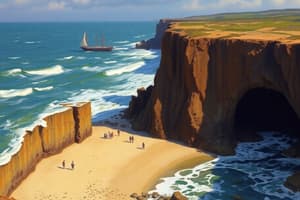Podcast
Questions and Answers
What is weathering?
What is weathering?
Weathering is the process in which rocks break down into sediments.
What are the two main types of weathering?
What are the two main types of weathering?
Physical and chemical.
What is erosion?
What is erosion?
Erosion is when moving water, glaciers, and winds carry sediments into a new location.
What process forms the particles that are involved in erosion?
What process forms the particles that are involved in erosion?
Signup and view all the answers
What is deposition?
What is deposition?
Signup and view all the answers
What is the main force that causes erosion and deposition?
What is the main force that causes erosion and deposition?
Signup and view all the answers
What are the three agents of erosion?
What are the three agents of erosion?
Signup and view all the answers
What is a delta?
What is a delta?
Signup and view all the answers
Explain how weathering, erosion, and deposition work together to form a delta.
Explain how weathering, erosion, and deposition work together to form a delta.
Signup and view all the answers
Define how oxbow lakes and meanders are related.
Define how oxbow lakes and meanders are related.
Signup and view all the answers
What is one way that physical and chemical weathering are the same?
What is one way that physical and chemical weathering are the same?
Signup and view all the answers
What is a difference between physical and chemical weathering?
What is a difference between physical and chemical weathering?
Signup and view all the answers
What is another difference between physical and chemical weathering?
What is another difference between physical and chemical weathering?
Signup and view all the answers
Study Notes
Weathering
- Weathering is the breakdown of rocks into smaller sediments.
- Two primary types of weathering:
- Physical weathering, which involves mechanical forces.
- Chemical weathering, which involves chemical reactions altering the rock's composition.
Erosion
- Erosion is the transportation of sediments by natural forces such as water, glaciers, and wind.
- Weathering is the process that generates the particles involved in erosion.
Deposition
- Deposition occurs when gravity causes sediments to settle at a new location after being transported.
Forces of Erosion and Deposition
- Gravity is the principal force driving both erosion and deposition processes.
Agents of Erosion
- The three main agents responsible for erosion are:
- Moving water
- Wind
- Ice
Deltas
- A delta is a fan-shaped deposit of sediment found at the base of a mountain where a stream flows into a flatter plain.
- Weathering, erosion, and deposition collaborate to create a delta:
- Weathering breaks rocks into sediments.
- Erosion transports these sediments to a new location.
- Deposition settles the sediments at the delta's base.
Oxbow Lakes and Meanders
- A meander is a bend or curve in a stream.
- An oxbow lake forms when a meander is cut off from the main stream during flooding, creating a separate lake.
- Flooding can cause a stream to reroute, bypassing a meander and forming an oxbow lake.
Physical vs. Chemical Weathering
- Physical weathering involves breaking down rocks without changing their composition.
- Chemical weathering involves alterations in rock composition due to chemical reactions.
- Both types of weathering aim to reduce rocks to sediments, allowing for erosion and deposition processes.
Studying That Suits You
Use AI to generate personalized quizzes and flashcards to suit your learning preferences.
Description
Test your knowledge on erosion, weathering, and deposition with these flashcards. Understand the processes that shape our landscapes, including physical and chemical weathering. Ideal for students learning about earth science!




